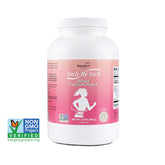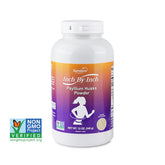Coenzyme Q10: Potent as Medicine

Although modern society is often said to be plagued by nutritional excess, ironically, a significant portion of the population in developed countries suffers from vitamin and mineral deficiencies. More precisely, it’s not nutritional excess but calorie excess. Instead of the overly simplistic and unrealistic advice to “eat well, sleep well, and exercise,” the real challenge lies in delivering essential nutrients in the right amounts at the right times.
If you're constantly fatigued at work or home and you've just turned 40, it might be time to check your levels of Coenzyme Q10 (also known as CoQ10 or CoQ). According to a survey by Nutradex based on Naver search data from May, only four health supplements saw a year-over-year increase in search volume—and CoQ10 searches surged by more than 50%, indicating a sharp rise in consumer interest.
Ray Kurzweil, a renowned futurist who reportedly takes over 100 supplements a day and spends more than 1 billion KRW (about $740,000 USD) annually on them, named CoQ10 as one of his top three must-take nutrients. He emphasized, “CoQ10 is especially critical for people my age as a powerful antioxidant.” The other two nutrients on his list are phosphatidylcholine and vitamin D.
The Korean Ministry of Food and Drug Safety recognizes CoQ10 for its antioxidant properties and potential to help lower high blood pressure. While dietary supplements are not intended to replace medication—especially in treating illnesses—some supplements deliver effects comparable to pharmaceuticals, and CoQ10 is one of them.
Some people may argue, “Supplements are chemicals that strain the liver and kidneys—can’t I just get nutrients from food?” While CoQ10 is naturally present in foods like beef, pork, eggs, broccoli, spinach, brown rice, sardines, mackerel, and peanuts, the typical daily intake from diet alone is only 4.2–7.2 mg. Even eating 1 kg of beef per day would only yield about 50 mg. Since the recommended daily intake is around 90–100 mg, it’s nearly impossible to meet the requirement through food alone. Moreover, CoQ10 begins to break down at temperatures above 50°C, which means cooking significantly reduces its potency.
A Recent Discovery with a Curious Origin
CoQ10 has only recently entered public awareness. In 1957, American biochemist Frederick Crane accidentally discovered it while studying a cow heart he had stored in a fridge and forgotten about. When he finally retrieved it weeks later, a yellow substance had appeared. His curiosity led to identifying the molecular structure of CoQ10 the following year and revealing its critical role in cell function. In 1977, Japan’s Kaneka Corporation began producing natural CoQ10 by fermenting yeast, leading to its global distribution.
The name “Coenzyme Q10” breaks down as follows: “Co” for “co-helper,” “enzyme” for enzymes it supports, “Q” for the quinone compound it contains, and “10” because its quinone structure includes 10 repeating isoprene units. While sometimes referred to as “Vitamin Q,” CoQ10 is unlike most vitamins in that it’s also produced by the human body. However, production peaks around age 20 and gradually declines. By your 40s, your CoQ10 levels may drop to 68.2% of peak levels, and by your 80s, to just 42.9%. If you were once physically active but now find yourself winded climbing stairs at 40, CoQ10 deficiency may be a factor.
A Power Generator in the Mitochondria
Mitochondria, ranging in size from 0.2 to 3 micrometers, are visible only under an electron microscope. Each liver cell contains about 1,000–3,000 mitochondria, and across the entire human body, there are over 10 quadrillion of them. More than 100 diseases—including dementia, Parkinson’s, and ALS—are linked to mitochondrial dysfunction.
Known as the “powerhouses of the cell,” mitochondria generate 95% of the body’s energy. CoQ10 plays a crucial role in the final step of energy production, dramatically boosting output. The food we eat and the oxygen we breathe undergo a series of reactions in the mitochondria called the TCA (citric acid or Krebs) cycle, which converts these inputs into heat and chemical energy. The heat maintains body temperature, while the chemical energy, or ATP (adenosine triphosphate), powers movement and cellular activity. CoQ10 supercharges this last phase, enabling the production of up to 36 ATP molecules per cycle.
Antioxidant Hero in the “Fantastic Five”
CoQ10 is also a potent antioxidant, helping neutralize reactive oxygen species (ROS), the “thugs” among oxygen molecules that damage cells. Mitochondria, with their constant redox reactions, are hotspots for ROS production. These unstable molecules steal electrons from other cells, causing oxidative stress and, ultimately, cell death or disease.
Antioxidants work by donating an electron to stabilize ROS. But once antioxidants lose their own electrons, they become weakened themselves. This is where the “antioxidant network” comes into play—key antioxidants help regenerate one another. UC Berkeley’s Dr. Lester Packer coined the term “Antioxidant Network” and identified the “Fantastic Five”: Vitamin C → Vitamin E → CoQ10 → Alpha-lipoic acid → Glutathione. CoQ10 revitalizes damaged vitamin E and alpha-lipoic acid molecules, helping protect mitochondria and your overall health.
This antioxidant activity extends to anti-aging skincare as well. CoQ10 helps prevent UV-A-induced oxidative stress, inhibits collagen-degrading enzymes, and reduces wrinkle depth—hence its inclusion in modern skincare products.
For Heart Health and Lower Blood Pressure
Dr. Erik Madrid, a U.S. physician, notes that CoQ10 may improve symptoms of conditions such as migraines, chronic fatigue syndrome, fibromyalgia, memory decline, high blood pressure, congestive heart failure, metabolic diseases, facial wrinkles, and tinnitus. A Spanish study found that women with fibromyalgia who took 300 mg of CoQ10 daily experienced significant symptom relief.
CoQ10 is found in highest concentrations in the heart, followed by the kidneys, liver, muscles, and pancreas. Since the heart beats 60–100 times per minute for a lifetime, it requires a steady CoQ10 supply. A deficiency can impair contraction and blood circulation, leading to hypertension, angina, heart attacks, or heart failure. Supplementation, on the other hand, improves vascular elasticity and protects artery walls from LDL cholesterol damage, supporting both prevention and treatment of high blood pressure.
Its benefits in heart failure (HF) are especially notable. In a 1993 Italian study of 1,113 patients with stage 2–3 heart failure, taking 50–150 mg of CoQ10 for three months led to significant improvements in symptoms such as cyanosis (81%), swelling (76.8%), arrhythmia (62%), and sleep disorders (60.2%). In South Korea, CoQ10 (under the name Ubidecarenone) is even sold as a general over-the-counter heart failure adjunct.
However, cholesterol-lowering statins, among the most prescribed drugs worldwide, also block HMG-CoA reductase, the enzyme necessary for both cholesterol and CoQ10 synthesis—leading to potential CoQ10 depletion and muscle pain. While some studies question the need for CoQ10 alongside statins, many doctors still recommend it, given its safety profile.
Similarly, beta-blockers like atenolol and metoprolol, commonly used for high blood pressure, may reduce CoQ10 levels, possibly explaining fatigue in some users.
Boosting Fertility in Men and Women
CoQ10 is highly concentrated in the head and neck of sperm cells, making it particularly relevant for couples facing infertility. One study showed that men with low sperm motility who took CoQ10 for six months saw a twofold improvement in sperm movement, enhancing conception chances.
Pharmacist Noh Yoon-jung, author of “Health Supplements You’ll Find at Pharmacies,” recommends CoQ10 to women in their mid to late 30s who are preparing for pregnancy, explaining that the body’s natural CoQ10 production peaks in the 20s and then declines. CoQ10 is thought to help protect ovarian cells from oxidative damage and support their function against age-related decline, improving pregnancy success rates.
The Korean Ministry of Food and Drug Safety recently added new warnings: “Avoid use while breastfeeding” and “Consult an expert if taking anticoagulants.” Interestingly, pregnant women were not included in the warning, possibly hinting at CoQ10’s positive role in fertility.
Effective for Other Mitochondrial Disorders
Due to its mitochondrial action, CoQ10 is also being studied for various intractable diseases. For instance, a recent Japanese study published in eClinicalMedicine showed that high-dose CoQ10 (ubiquinol) improved motor function by 24% in patients with multiple system atrophy (MSA), a condition also suffered by former Korean President Roh Tae-woo. The trial involved 139 participants, with 69 receiving 1,500 mg of CoQ10 daily for 48 weeks.
In 2020, a research team at Seoul National University Hospital found that direct brain delivery of CoQ10 could help protect dopamine-producing neurons in Parkinson’s disease, as reported in Scientific Reports.
There is even research into CoQ10’s role in cancer treatment. Taking CoQ10 for two or more years may reduce side effects from breast cancer chemotherapy, and in two advanced-stage patients, daily doses of 390 mg were linked to recovery from metastases after 6–11 months. While more evidence is needed, these findings are promising.
Even dental care is exploring potential uses of CoQ10 and is even being discussed in dental treatments.
Research suggests that Coenzyme Q10 may help improve gingivitis (gum inflammation) and periodontal disease. Since gum tissue contains a high concentration of mitochondria, CoQ10, which supports mitochondrial function, may aid in maintaining healthy gums and promoting tissue repair.
Source: 주간조선(http://weekly.chosun.com)
Dailycore-CoQ10 Max
600mg x 30capsules
$24.99

![Inch By Inch (Psyllium Husks Powder) [Buy 4 Get 1 FREE] - Health Korea Shop](http://healthkoreashop.com/cdn/shop/files/health-korea-shop-default-title-inch-by-inch-psyllium-husks-powder-buy-4-get-1-free-26476880429165_165x.gif?v=1757024963)
![Inch By Inch (Psyllium Husks Powder) [Buy 4 Get 1 FREE] - Health Korea Shop](http://healthkoreashop.com/cdn/shop/files/health-korea-shop-default-title-inch-by-inch-psyllium-husks-powder-buy-4-get-1-free-26471389102189_165x.jpg?v=1757024971)
![Inch By Inch (Whole Psyllium Husks) [Buy 3 Get 1 FREE] - Health Korea Shop](http://healthkoreashop.com/cdn/shop/files/health-korea-shop-default-title-inch-by-inch-whole-psyllium-husks-buy-3-get-1-free-26471348764781_165x.jpg?v=1757024989)

![Inch By Inch (Organic Psyllium Husks Powder) [Buy 3 Get 1 FREE] - Health Korea Shop](http://healthkoreashop.com/cdn/shop/files/health-korea-shop-default-title-inch-by-inch-organic-psyllium-husks-powder-buy-3-get-1-free-26471394771053_165x.jpg?v=1757024965)
![Inch By Inch (Organic Psyllium Husks Powder) [Buy 3 Get 1 FREE] - Health Korea Shop](http://healthkoreashop.com/cdn/shop/files/health-korea-shop-default-title-inch-by-inch-organic-psyllium-husks-powder-buy-3-get-1-free-26471394803821_165x.png?v=1757025003)

